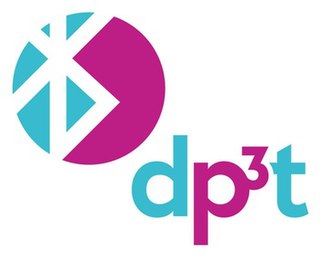Bluetooth is a short-range wireless technology standard that is used for exchanging data between fixed and mobile devices over short distances and building personal area networks (PANs). In the most widely used mode, transmission power is limited to 2.5 milliwatts, giving it a very short range of up to 10 metres (33 ft). It employs UHF radio waves in the ISM bands, from 2.402 GHz to 2.48 GHz. It is mainly used as an alternative to wire connections, to exchange files between nearby portable devices and connect cell phones and music players with wireless headphones.

Nordic Semiconductor ASA is a Norwegian fabless technology company specializing in designing ultra-low-power wireless communication semiconductors and supporting software for engineers developing and manufacturing IoT products.
Proximity marketing is the localized wireless distribution of advertising content associated with a particular place. Transmissions can be received by individuals in that location who wish to receive them and have the necessary equipment to do so.
A Bluetooth stack is software that is an implementation of the Bluetooth protocol stack.

Airplane mode is a setting available on smartphones and other portable devices. When activated, this mode suspends the device's radio-frequency (RF) signal transmission technologies, effectively disabling all analog voice, and digital data services, when implemented correctly by the electronic device software author.
Bluetooth Low Energy is a wireless personal area network technology designed and marketed by the Bluetooth Special Interest Group aimed at novel applications in the healthcare, fitness, beacons, security, and home entertainment industries. It is independent of classic Bluetooth and has no compatibility, but Bluetooth Basic Rate/Enhanced Data Rate (BR/EDR) and LE can coexist. The original specification was developed by Nokia in 2006 under the name Wibree, which was integrated into Bluetooth 4.0 in December 2009 as Bluetooth Low Energy.
Asset tracking refers to the method of tracking physical assets, either by scanning barcode labels attached to the assets or by using tags using GPS, BLE, LoRa, or RFID which broadcast their location. These technologies can also be used for indoor tracking of persons wearing a tag.
DASH7 Alliance Protocol (D7A) is an open-source wireless sensor and actuator network protocol, which operates in the 433 MHz, 868 MHz and 915 MHz unlicensed ISM band/SRD band. DASH7 provides multi-year battery life, range of up to 2 km, low latency for connecting with moving things, a very small open-source protocol stack, AES 128-bit shared-key encryption support, and data transfer of up to 167 kbit/s. The DASH7 Alliance Protocol is the name of the technology promoted by the non-profit consortium called the DASH7 Alliance.

AirPlay is a proprietary wireless communication protocol stack/suite developed by Apple Inc. that allows streaming between devices of audio, video, device screens, and photos, together with related metadata. Originally implemented only in Apple's software and devices, it was called AirTunes and used for audio only. Apple has since licensed the AirPlay protocol stack as a third-party software component technology to manufacturers that build products compatible with Apple's devices.

Apple Wallet is a digital wallet developed by Apple Inc. and included with iOS and watchOS that allows users to store Wallet passes such as coupons, boarding passes, student ID cards, government ID cards, business credentials, resort passes, car keys, home keys, event tickets, public transportation passes, store cards, and – starting with iOS 8.1 – credit cards, and debit cards for use via Apple Pay.

iBeacon is a protocol developed by Apple and introduced at the Apple Worldwide Developers Conference in 2013. Various vendors have since made iBeacon-compatible hardware transmitters – typically called beacons – a class of Bluetooth Low Energy (BLE) devices that broadcast their identifier to nearby portable electronic devices. The technology enables smartphones, tablets and other devices to perform actions when in proximity to an iBeacon.
Thread is an IPv6-based, low-power mesh networking technology for Internet of things (IoT) products. The Thread protocol specification is available at no cost; however, this requires agreement and continued adherence to an End-User License Agreement (EULA), which states that "Membership in Thread Group is necessary to implement, practice, and ship Thread technology and Thread Group specifications."

Briar is an open-source software communication technology, intended to provide secure and resilient peer-to-peer communications with no centralized servers and minimal reliance on external infrastructure. Messages can be transmitted through Bluetooth, Wi-Fi, over the internet via Tor or removable storage, such as USB sticks. All communication is end-to-end encrypted. Relevant content is stored in encrypted form on participating devices. Long-term plans for the project include support for distributed applications such as crisis mapping and collaborative document editing.
Nearables are a type of smart object. They are everyday items that have small, wireless computing devices attached to them. These devices can be equipped with a variety of sensors and work as transmitters to broadcast digital data through a variety of methods, but they usually use the Bluetooth Smart protocol. Due to this, these objects are able to provide mobile devices in range with information about their location, state and immediate surroundings. The word 'nearables' is a reference to wearable technology – electronic devices worn as part of clothing or jewellery.
Mobile location analytics (MLA) is a type of customer intelligence and refers to technology for retailers, including developing aggregate reports used to reduce waiting times at checkouts, improving store layouts, and understanding consumer shopping patterns. The reports are generated by recognizing the Wi-Fi or Bluetooth addresses of cell phones as they interact with store networks.
Eddystone was a Bluetooth Low Energy beacon profile released by Google in July 2015. In December 2018 Google stopped delivering both Eddystone and Physical Web beacon notifications. The Apache 2.0-licensed, cross-platform, and versioned profile contained several frame types, including Eddystone-UID, Eddystone-URL, and Eddystone-TLM. Eddystone-URL was used by the Physical Web project, whereas Eddystone-UID was typically used by native apps on a user's device, including Google's first party apps such as Google Maps.
Bluetooth beacons are hardware transmitters — a class of Bluetooth Low Energy (LE) devices that broadcast their identifier to nearby portable electronic devices. The technology enables smartphones, tablets and other devices to perform actions when in close proximity to a beacon.

The Temporary Contact Numbers Protocol, or TCN Protocol, is an open source, decentralized, anonymous exposure alert protocol developed by Covid Watch in response to the COVID-19 pandemic. The Covid Watch team, started as an independent research collaboration between Stanford University and the University of Waterloo was the first in the world to publish a white paper, develop, and open source fully anonymous Bluetooth exposure alert technology in collaboration with CoEpi after writing a blog post on the topic in early March.

Digital contact tracing is a method of contact tracing relying on tracking systems, most often based on mobile devices, to determine contact between an infected patient and a user. It came to public prominence in the form of COVID-19 apps during the COVID-19 pandemic. Since the initial outbreak, many groups have developed nonstandard protocols designed to allow for wide-scale digital contact tracing, most notably BlueTrace and Exposure Notification.

Decentralized Privacy-Preserving Proximity Tracing is an open protocol developed in response to the COVID-19 pandemic to facilitate digital contact tracing of infected participants. The protocol, like competing protocol Pan-European Privacy-Preserving Proximity Tracing (PEPP-PT), uses Bluetooth Low Energy to track and log encounters with other users. The protocols differ in their reporting mechanism, with PEPP-PT requiring clients to upload contact logs to a central reporting server, whereas with DP-3T, the central reporting server never has access to contact logs nor is it responsible for processing and informing clients of contact. Because contact logs are never transmitted to third parties, it has major privacy benefits over the PEPP-PT approach; however, this comes at the cost of requiring more computing power on the client side to process infection reports.







